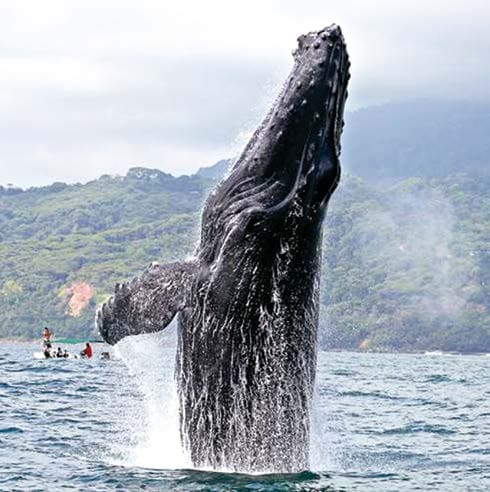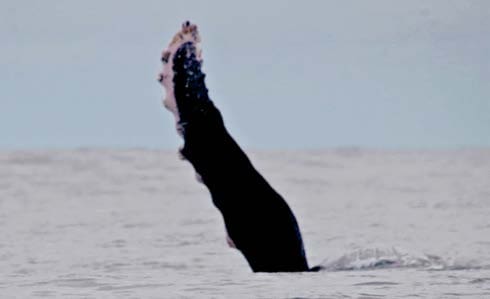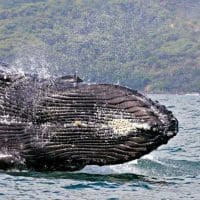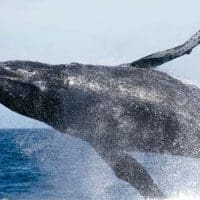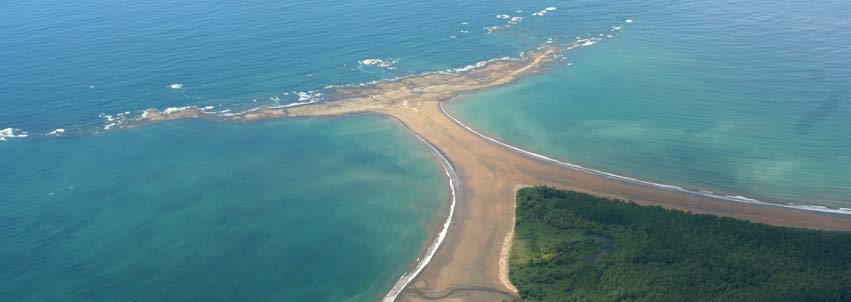
Cool Adventure – A Whale’s Tale: Whale Watching in Costa Rica
Costa Rica has long been known as a destination to see wildlife such as birds, sloths, frogs and monkeys. But in recent years, a new attraction has emerged: whale watching. According to the Costa Rican Institute for Tourism (ICT), whale watching is one of the fastest-growing segments of tourist activities in the country, with the number recorded going from fewer than 30,000 a year in 2008 to now well over 150,000 a year.
It is a surprise it took so long.
Costa Rica is blessed with being the only place in the world where you can find two different populations of humpback whale (Megaptera novaeangliae) migrating to the same location. One group, native to the Pacific coast from Baja California, Mexico, up to Alaska, reaches Costa Rica between December and March. The second group, in one of the longest of any animal migration, comes here all the way from Antarctica during July through October. Both whale species head to the warmer, nutrient-rich waters of protected bays around Golfito in the Golfo Dulce, and the Gulf of Papagayo, but mostly the Bahía Ballena area to the north of the Osa Peninsula. This extends from Dominical down to Sierpe and Drake Bay, centered in Uvita and the Parque Nacional Marino Ballena.
Ballena National Marine Park, best known for its appropriately shaped whale tail sandbar, was created in 1996 to protect these important waters where the whales come to breed and deliver their calves. The health of the species is improved by cross-breeding of the two whale groups, which occurs only here, underscoring the importance of protecting this part of the coast.
You can take whale-watching trips seasonally between Jacó, Dominical and Golfito, but Uvita is the only area that runs whale watching almost all year round. On these boat trips you can also see migrating green and hawksbill turtles, and sometimes catch a glimpse of pilot whales (actually a member of the dolphin family). Other dolphin species in the area include spotted (Stenella attenuata), bottlenose (Tursiops truncatus) — Flipper was a bottlenose — spinner (Stenella longirostris) — which amazingly corkscrew themselves in the air — rough-toothed (Steno bredanensis), and common (Delphinus delphis).
The main event, however, are the whales. Males are slightly smaller than females, which can reach 18 meters (about 50 feet) in length and weigh 40 tons. The young grow from about 7 meters long at birth to double that length while remaining with their mothers in the safe and warm bay waters.
From tour sites, you can spot whales on the surface in a variety of actions: spouting or blowing (they are air breathers), spy hopping — they actually come up to look around for others — fin slapping, fluke flipping and breaching — throwing their entire bodies into the air. Scientists believe these behaviors may be a form of communication. Another theory is that the whales leap clear of the water trying to rid themselves of parasites and barnacles.
It’s also not hard to believe they leap and breach simply because they can … out of sheer fun and joy.
So venture out to watch and be in awe of these behemoths. You can go right now, and also attend a special festival that’s held every September in Bahía Ballena: Festival de Ballenas y Delfines. For more information: www.festivaldeballenasydelfines.com

